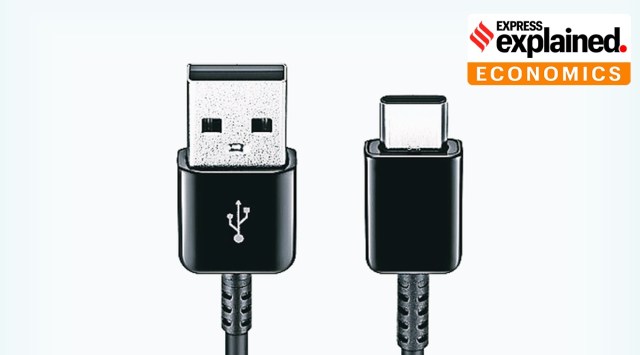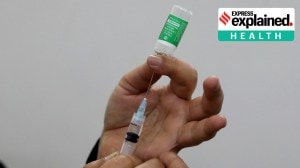- India
- International
USB-C for all: Why EU wants same port across electronic devices
The executive arm of the European Union (EU) has proposed that USB Type-C will be the common port, and this move is expected to hit iPhone maker Apple the most.
 The European Commission has proposed USB-C to be the common charging port to allow consumers to charge their devices with the same USB-C charger, regardless of the device brand.
The European Commission has proposed USB-C to be the common charging port to allow consumers to charge their devices with the same USB-C charger, regardless of the device brand.The European Commission has proposed a plan to harmonise charging ports and fast charging technology for electronic devices — something that could force OEMs to adopt a single technology for most of their devices. The executive arm of the European Union (EU) has proposed that USB Type-C will be the common port, and this move is expected to hit iPhone maker Apple the most given that it uses its proprietary Lightening connector for iPhones and most iPads.
What exactly is the proposal?
The European Commission has proposed USB-C to be the common charging port to allow consumers to charge their devices with the same USB-C charger, regardless of the device brand. It is also unbundling the sale of charger from the sale of electronic device to limit the number of “unwanted chargers” purchased or left unused.
Once the proposal is through, original equipment manufacturers (OEMs) will have to provide the common standardised port for devices such as smartphones, tablets, cameras, headphones, portable speakers and handheld video-game consoles.
 The proposal, however, only covers wired chargers and excludes wireless charging from its ambit, meaning that only if a device uses a cable to be charged will it need to have a USB-C port. In case the device is only to be charged wirelessly, there is no compulsion to have a USB-C port in the device.
The proposal, however, only covers wired chargers and excludes wireless charging from its ambit, meaning that only if a device uses a cable to be charged will it need to have a USB-C port. In case the device is only to be charged wirelessly, there is no compulsion to have a USB-C port in the device.

Moreover, the proposal to harmonise fast charging technology could address the concern with USB-C chargers, where a number of users have experienced their devices going kaput because of mismatch in the input power being provided and the output power that the devices can handle.
Why has the EU brought in this proposal?
The European Commission has said that on average, consumers in the EU own around three mobile phone chargers, of which they use two on a regular basis. Despite this, 38 per cent of consumers have reported having experienced problems at least once that they could not charge their mobile phone because available chargers were incompatible. It added that consumers spend approximately €2.4 billion annually on standalone chargers that do not come with electronic devices.
In addition, disposed of and unused chargers are estimated to pile up to 11,000 tonnes of e-waste every year.
Margrethe Vestager, Executive Vice-President for a Europe fit for the Digital Age, said: “European consumers were frustrated long enough about incompatible chargers piling up in their drawers. We gave industry plenty of time to come up with their own solutions, now time is ripe for legislative action for a common charger. This is an important win for our consumers and environment, and in line with our green and digital ambitions.”
How does the USB-C port stack up against Apple’s Lightening connector?
The Lightening connector was introduced in 2012, two years before the USB-C standards were finalised and at the time, the other primary means of device charging was the microUSB port, which was significantly inferior to the Lightening connector in terms of durability, power and ease of use. Some of these concerns with the microUSB were addressed in the USB-C connectors when they were introduced in 2014.
However, the Lightening connectors continued to have some durability advantages over the USB-C cable. For instance, the connector tabs on the Lightening chargers were placed on the cable itself, instead of being placed on the device. Because of this, in case of any malfunction of the connector tab, the consumer would simply need to replace the cable. In case of the USB-C protocol, the connector tabs are provided in the device ports, meaning any malfunction of these tabs would require replacement of the port.
Also, Lightening connectors are slimmer than USB-C connectors allowing Apple to build significantly slimmer devices.
The USB-C port also carries some advantages to it, one of which is its ability to handle higher power. The Lightening cable is known to have handled up to 18 W of power output, but since there are only a limited number of devices that use the Lightening cable to get charged, the output handling is restricted by what the devices can handle, as opposed to what the cable itself can. USB-C, on the other hand, is designed to handle up to 100 W of power output, making it more ubiquitous for the entire device ecosystem, including heavier products such as laptops.
What could be the impact of the proposal?
The European Commission’s proposal will now need to be adopted by the European Parliament and the European Council by ordinary legislative procedure, and a transition period of 24 months from the date of adoption will give the industry time to adapt before the entry into application.
According to Reuters, Apple said in a statement that it disagreed with the proposal. “We remain concerned that strict regulation mandating just one type of connector stifles innovation rather than encouraging it, which in turn will harm consumers in Europe and around the world,” an Apple spokesperson told the news agency.
However, if passed, the new rules could force Apple to introduce USB-C ports on its devices. Given the value that Apple derives from uniformity in its production lines for markets across the globe, this could potentially result in Apple devices being changed for other jurisdictions as well.
It is noteworthy though that over the years Apple itself has been moving away from the Lightening cable. It has already introduced MacBooks and iPads that use USB-C charging ports.
Also, it is rumoured that Apple has been working on a port-less iPhone that would be exclusively charged using a wireless charger.
Newsletter | Click to get the day’s best explainers in your inbox
More Explained
EXPRESS OPINION
May 01: Latest News
- 01
- 02
- 03
- 04
- 05









































